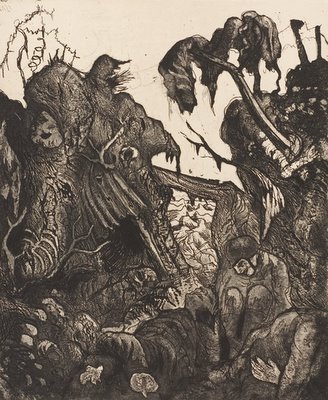Otto Dix at NGA
Getting excited about the Otto Dix exhibition which opens at the National Gallery of Australia tomorrow. They're showing the complete 'Der Krieg' [War] series, which was printed in 1924.
Dix was born in 1891, the son of an ironworker. He trained as a painter of wall decorations and later taught himself how to paint on canvas. He volunteered as a machine-gunner during World War I and in 1915 he was sent to the Western Front. He was at the Somme during the major allied offensive of 1916, and was wounded several times.
The series puts down Dix’s own experiences of the war he lived through, and is his claim to be considered in the long line of artists of agony and suffering like Goya, and be ranked along side them. The experience obviously affected him profoundly as an individual and as an artist, and he took every opportunity, both during his active service and afterwards, to document it.
Many have the empirical quality of eye witness accounts, while others are generalised, like horrible memories from the past.
The series is overtly modelled on Goya’s 'Los Desastres de la Guerra' [The disasters of war]. These are Goya’s own account of the horrors of the Napoleonic invasion and the Spanish War of Independence from 1808 to 1814. His cycle of 82 etchings, which he worked on for a decade after the Spanish War of Independence were not, however, published until 1863, long after his death.
This series resembles Goya’s also in its astonishing variety of approaches. Goya’s prints have a freewheeling approach to technique, often highly experimental for their time. Dix seems to have taken this up as a model, exploiting the license Goya gave him. Der Kreig also exploits the possibilities of a long sequence of images whose psychological and emotional effect is cumulative and overwhelming.
Several seem to be direct transcriptions of fact, like the strangely calm and precise drawing of a recuperating soldier in hospital pyjamas, who regards us cooly despite the fact that most of his face is missing and his whole head is a Frankinstein’s monster of scar tissue and stitching.
They share Goya’s heavy sense of irony. A bright sunrise brings light and warmth to the scarred battlefield, while two German soldiers crawl across the picture in the dark foreground like animals.
The art of the northern Renaissance weighs heavy on Dix. Several are obviously genre images, like the skull which rots on the battlefield while worms crawl from its eye sockets. Pictures like these indicate his belief in an equivalence between the horror of the modern present and the sufferings of the past in a direct challenge to the early twentieth century orthodoxy of progress and modernity.
In the exhibition’s introduction by Mark Henshaw, he points out that it has become the common interpretation of this cycle to see it as an admonition against the barbarity of war. And there is no doubt that as a human document it is a powerful cautionary work. At a psychological level, however, its truth goes deeper than this. Dix was both horrified and fascinated by the experience of war.
In 1963, explaining why he volunteered for the army in World War I he said:
I had to experience how someone beside me suddenly falls over and is dead and the bullet has hit him squarely. I had to experience that quite directly. I wanted it. I’m therefore not a pacifist at all – or am I? Perhaps I was an inquisitive person. I had to see all that myself. I’m such a realist, you know, that I have to see everything with my own eyes in order to confirm that it’s like that. I have to experience all the ghastly, bottomless depths of life for myself...One of the most disturbing things about the series is this paradoxical quality; both of horror and fascination. It looks at times like some elaborate nightmare, but it’s also gorgeously evoked. There’s an almost perverse delight in the rendering of horrific detail, which reveals the addictive quality of battle that I’ve heard old soldiers relate. This makes the work nakedly honest in a way most war art is not.
I’m particulary excited to hear that this edition of the series has been acquired by the National Gallery.
The exhibition continues until the 30th of April next year.


.jpg)





No comments:
Post a Comment